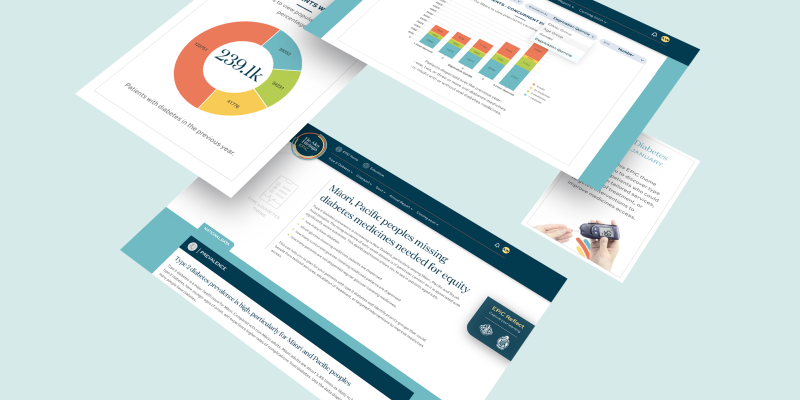EPiC user guide

EPiC (Evaluating Prescribing to inform Care) is a free, interactive, personalised, report-style dashboard on the He Ako Hiringa website. Presentation of large data sets in a series of interactive charts allows EPiC users to easily compare medicine use across different populations and demographics, using age, gender, ethnicity, and socioeconomic deprivation quintile filters. Data can be viewed at the prescriber, practice and national levels.
Data themes, with relevant data stories, allow exploration of national problems of prescribing practice such as polypharmacy, and medicine overutilisation and underutilisation in different populations. These issues connect to broader strategies of improving equitable access to medicines and health improvement.
As well as an Annual Report, EPiC themes include antibiotics, asthma, cardiovascular disease, cilazapril, gout, opioids, type 2 diabetes, and youth mental health. The centre panel of this EPiC user guide shows a snapshot of the asthma data theme, annotated with numbered points to help familiarise you with EPiC’s functionality.
Example of how to use your EPiC data
GP Sue Perdock works eight sessions per week in a busy Northland practice where registered nurse, Anahera, has recently joined the team. Both wāhine are keen to initiate quality improvement activities to improve patient care. Sue suggests they focus on asthma, as this is one of the most common long-term conditions in the patients she sees.
Starting point: Sue logs into EPiC and explores the practice data on the asthma dashboard. She is reminded that the asthma guidelines recommend no one 12 years or older should be prescribed a short-acting beta agonist (SABA), such as salbutamol, alone. She is surprised, therefore, to see that 506 practice patients were dispensed SABA without maintenance therapy in the last 12 months – representing 37.5 per cent of their enrolled patients with asthma. Clicking on the National data tab, Sue is momentarily relieved to see their practice-level data are similar (proportionally) to the national data. However, this is of little comfort as she knows that SABA-only therapy does not constitute good asthma management and it increases the risk of severe exacerbations. Meanwhile, Anahera has been looking at online asthma resources and has bookmarked the management guidelines on the Asthma Respiratory Foundation website as well as the asthma page on He Ako Hiringa.
Planning: After a quick catch up with Anahera, Sue presents their findings and concerns at the weekly clinical meeting. She shows the team that they collectively have a large number of patients taking SABA without maintenance therapy, and the team are supportive of her leading a quality improvement plan to address this. Practice manager, Abel, is especially pleased as this will help kick-start their Cornerstone CQI module accreditation.
Aim: The clinical team will review patients taking SABA without maintenance therapy and switch them to SMART/AIR therapy if appropriate.
Actions: Anahera picked up copies of the ARF asthma guideline Quick Reference Guide at a conference last year – she places these in the staff room and emails everyone with links to ARF and He Ako Hiringa and encourages them to explore the online resources. Abel reminds the team to keep a log of their readings and learnings for their CPD records, pointing out how easy it is to do using the “capture” button on He Ako Hiringa online resources.
Sue decides to use the He Ako Hiringa Reflect and Audit template for their planning and data collection. She shows Anahera and Abel how to access this through the dark blue “EPiC Reflect” tab on the right side of the EPiC dashboard screen. Abel downloads and saves the template and, over the following few weeks, the three of them populate the document with current data and their planned actions, updating the rest of the team at the weekly clinical meetings.
From the agreed start date, the team assess inhaler technique and adherence and complete an asthma control test for every patient with asthma, at each presentation to the practice. For patients with partially or poorly controlled asthma, they discuss possible treatment options such as a step up in the level of treatment required or a change to SMART/AIR therapy if asthma is not adequately controlled, or if there is poor lung function or recent severe exacerbation.
Results: When the EPiC asthma practice dashboard is reviewed nine months later it shows that 250 patients are now being dispensed SABA without maintenance therapy (down from 506 patients), representing 18.5 per cent of their enrolled patients with asthma (down from 37.5 per cent). Sue again compares these numbers with national-level data at the same timepoint and sees that the proportion of their practice patients taking SABA alone is now significantly less than it is (on average) nationally.
Conclusion and future direction: This was a successful intervention, demonstrating that implementing quality improvement activities around data displayed in EPiC can be simple and effective. Sue, Anahera and the other clinical staff decide to continue the initiative over the next three to six months, to review patients with asthma who may have missed the intervention. They also plan to find patients dispensed six or more SABA inhalers and invite them to the clinic for review. Anahera continues to give regular progress updates at the weekly meetings.
Abel has been liaising with the RNZCGP quality team throughout the year and is using the asthma intervention documentation to contribute towards the practice’s CQI Cornerstone module. Abel has also ensured the doctors and nurses who have been involved in the project have recorded their learning in their individual continuing professional development profiles.
Sue, Anahera and Abel are now planning their next quality improvement activity, using EPiC data to optimise urate-lowering therapy in Māori and Pacific peoples who have gout.
- Click here for an easy-to-print version.of the EPiC user guide.
- Click here to explore EPiC.
Acknowledgments
Written by: Dr Noni Richards (BPharm, PhD), senior consultant at Matui Ltd
Content updates
- February 2024: User guide and example updated (cilazapril dashboard screenshot replaced with asthma dashboard screenshot and cilazapril 'case study' changed to SABA data example).